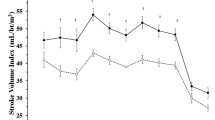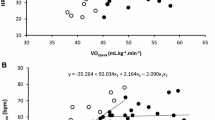Summary
Ten men and 11 women were studied to determine the effect of experimentally equating haemoglobin concentration ([Hb]) on the sex difference in maximal oxygen uptake (\(\dot V_{O_{2_{\max } } } \)).\(\dot V_{O_{2_{\max } } } \) was measured on a cycle ergometer using a continuous, load-incremented protocol. The men were studied under two conditions: 1) with normal [Hb] (153 g · L−1) and 2) two days following withdrawal of blood, which reduced their mean [Hb] to exactly equal the mean of the women (134 g· L−1). Prior to blood withdrawal,\(\dot V_{O_{2_{\max } } } \) expressed in L · min−1 and relative to body weight and ride time on the cycle ergometer test were greater (p<.01) in men by 1.11 L · min−1 (47%), 4.8 ml · kg−1 min−1 (11.5%) and 5.9 min (67%), respectively, whereas\(\dot V_{O_{2_{\max } } } \) expressed relative to fat-free weight (FFW) was not significantly different. Equalizing [Hb] reduced (p<.01) the mean\(\dot V_{O_{2_{\max } } } \) of the men by 0.26 L · min−1 (7.5%), 3.2 ml · kg−1 min−1 (6.9%) or 4.1 ml · kg FFW−1 min−1 (7.7%), and ride time by 0.7 min (4.8%). Equalizing [Hb] reduced the sex difference for\(\dot V_{O_{2_{\max } } } \) less than predicted from proportional changes in the oxygen content of the arterial blood and arteriovenous oxygen content difference during maximal exercise. It was concluded that the sex difference in [Hb] accounts for a significant, but relatively small portion of the sex difference in\(\dot V_{O_{2_{\max } } } \) (L · min−1). Other factors such as the dimensions of the oxygen transport system and musculature are of greater importance.
Similar content being viewed by others
References
Allen T, Peng M, Chen K, Huang T, Chang C, and Fang H (1956) Prediction of blood volume and adiposity in man from body weight and the cube root of height. Metabolism 5:328–345
åstrand P-O (1952) Experimental studies of physical working capacity in relation o sex and age. Munksgaard, Copenhagen, pp 103–115
åstrand P-O, Cuddy T, Saltin B, Stenberg J (1964) Cardiac output during submaximal and maximal work. J Appl Physiol 19:268–274
Balke B, Brillo P, Konecci E, Luft U (1954) Work capactiy after blood donation. J Appl Physiol 7:231–238
Brozek J, Grande F, Anderson J, Keys A (1963) Densitometric analysis of body composition: revision of some quantitative assumptions. Ann NY Acad Sci (USA) 110:113–140
Buick F, Gledhill N, Froese A, Spriet L, Myers E (1980) Effect of induced erythrocythemia on aerobic work capacity. J Appl Physiol 48:636–642
Cureton K (1981) Matching male and female subjects using\(\dot V_{O_{2_{\max } } } \). Res Q Exerc Sport 52:264–268
Drinkwater B (1973) Physiological responses of women to exercise. In: Wilmore J (ed) Exercise and sport sciences reviews, vol. 1. Academic Press, New York, pp 125–154
Ekblom B, Goldberg A, Gullbring B (1972) Response to exercise after blood loss and reinfusion. J Appl Physiol 33:175–180
Ekblom B, Wilson G, åstrand P-O (1976) Central circulation during exercise after venesection and reinfusion of red blood cells. J Appl Physiol 40:379–383
Fortney S, Nadel E, Wegner C, Bove J (1981) Effect of acute alterations in blood volume on circulatory performance in humans. J Appl Physiol 50:292–298
Freedson P (1981) The influence of hemoglobin concentration on exercise cardiac output. Int J Sports Med 2:81–86
Gaehtgens P, Kreutz F, Albrecht K (1979) Optimal hematocrit for canine skeletal muscle during rhythmic isotonic exercise. Eur J Appl Physiol 41:27–39
Gledhill N (1985) The influence of altered blood volume and oxygen transport capacity on aerobic performance. In: Turjung R (ed) Exercise and sport sciences reviews, vol. 13. Macmillan, New York, pp 75–94
Hermansen L (1973) Oxygen transport during exercise in human subjects. Acta Physiol Scand [Suppl] 399:76–80
Horstman D, Gleser M, Wolfe D, Tryon T, Dalehut J (1974) Effects of hemoglobin reduction on\(\dot V_{O_{2_{\max } } } \) and related hemodynamics in exercising dogs. J Appl Physiol 37:97–102
Horstman D, Weiskopf R, Jackson R (1980) Work capacity during 3-week sojourn at 4,300 m: effects of relative polycythemia. J Appl Physiol 49:311–318
Levy M, Share L (1953) The influence of erythrocyte concentration upon the pressure-flow relationships in the dog's hind limb. Circ Res 1:247–255
Rowell L, Taylor H, Wang T (1964) Limitations to prediction of maximal oxygen intake. J Appl Physiol 19:919–927
Rowell L (1974) Human cardiovascular adjustments to exercise and thermal stress. Physiol Rev 54:75–159
Sparling P (1980) A meta-analysis of studies comparing maximal oxygen uptake in men and women. Res Q Exerc Sport 51:542–552
Sparling P, Cureton K (1983) Biological determinants of the sex difference in 12-min run performance. Med Sci Sports Exerc 15:218–223
Thompson J, Stone J, Ginsberg A, Hamilton P (1982) O2 transport during exercise following blood reinfusion. J Appl Physiol 53:1213–1219
Von Dobeln W (1956) Human standard and maximal metabolic rate in relation to fat-free body mass. Acta Physiol Scand [Suppl] 126:1–78
Williams M, Wesseldine S, Somma T, Schuster R (1981) The effect of induced erythrocythemia upon 5-mile treadmill run time. Med Sci Sports Exerc 13:169–175
Wilmore J, Costill D (1974) Semiautomated Systems approach to the assessment of oxygen uptake during exercise. J Appl Physiol 36:618–620
Woodson R, Wills R, Lenfant C (1978) Effect of acute and established anemia on O2 transport at rest, submaximal and maximal work. J Appl Physiol 44:36–43
Zwiren L, Cureton K, Hutchinson P (1983) Comparison of circulatory responses to submaximal exercise in equallytrained men and women. Int J Sports Med 4:255–259
Author information
Authors and Affiliations
Rights and permissions
About this article
Cite this article
Cureton, K., Bishop, P., Hutchinson, P. et al. Sex difference in maximal oxygen uptake. Europ. J. Appl. Physiol. 54, 656–660 (1986). https://doi.org/10.1007/BF00943356
Accepted:
Issue Date:
DOI: https://doi.org/10.1007/BF00943356




